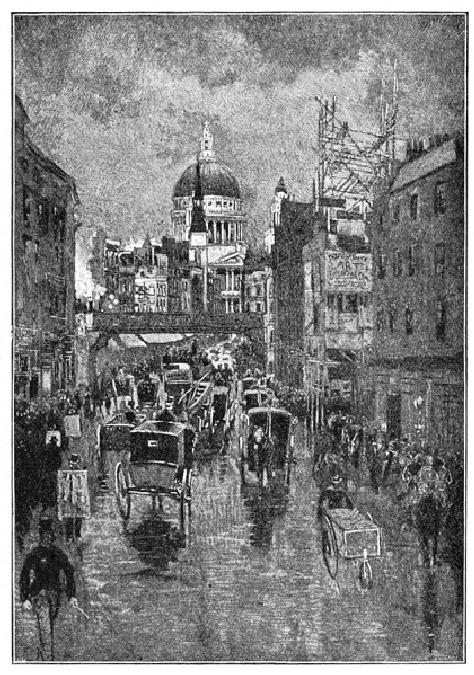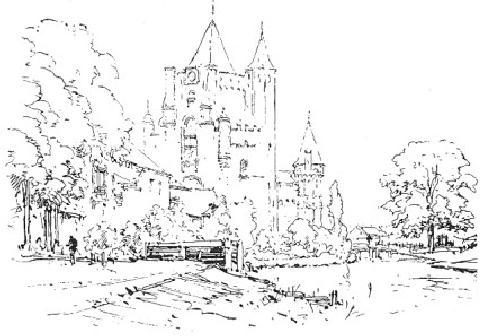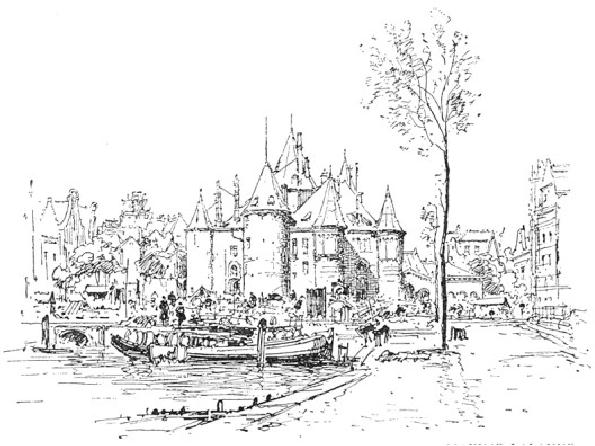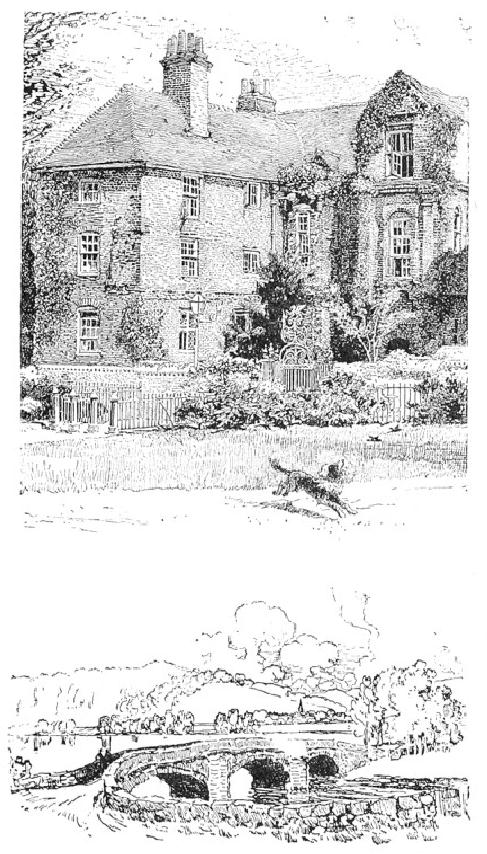 |
STYLE IN PEN DRAWING |
| << ACKNOWLEDGMENT |
| MATERIALS >> |
conventions.
Sculpture reproduces the forms of
Nature, but discards
the
color
without any shock to our
ideas of verity; Painting
gives us the
color,
but not the third
dimension, and we are satisfied; and
Architecture
is
purely
conventional,
since it does not even aim
at the imitation of
natural
form.
Of
the kindred arts which group
themselves under the head of
Painting,
The
none
is based on such broad conventions as
that with which we
are
Conventions
immediately
concerned--the art of Pen
Drawing. In this
medium,
of
Line
Nature's
variety of color, when not
positively ignored, is suggested
by
Drawing
means
of sharp black lines, of varying
thickness, placed more or
less
closely
together upon white paper;
while natural form depends
primarily
for
its representation upon
arbitrary boundary lines.
There is, of course,
no
authority in Nature for a
positive outline: we see
objects only by the
difference
in color of the other
objects behind and around
them. The
technical
capacity of the pen and ink
medium, however, does not
provide
a
value corresponding to every
natural one, so that a broad
interpretation
has
to be adopted which eliminates
the less positive values;
and, that
form
may not likewise be
sacrificed, the outline
becomes necessary, that
light
objects may stand relieved against
light. This outline is the
most
characteristic,
as it is the most indispensable, of
the conventions of
line
drawing.
To seek to abolish it only
involves a resort to expedients no
less
artificial,
and the results of all
such attempts, dependent as
they
necessarily
are upon elaboration of
color, and a general indirectness
of
method,
lack some of the best
characteristics of pen drawing.
More
frequently,
however, an elaborate color-scheme is
merely a straining at
the
technical limitations of the pen in an
effort to render the
greatest
possible
number of values.
It
may be worth while to
inquire whether excellence in
pen drawing
consists
in thus dispensing with its
recognized conventions, or in
otherwise
taxing the technical
resources of the instrument.
This involves
the
question of Style,--of what
characteristic pen methods
are,--a
question
which we will briefly
consider.
It
is a recognized principle that
every medium of art
expression should What
be
treated with due regard to its nature and
properties. The sculptor
Constituted
varies
his technique according as he
works in wood, granite, or
marble; "Style"
the
painter handles his
water-color in quite another
manner than that he
would
employ on an oil-painting of the
same subject; and the
architect,
with
the subtle sense of the
craftsman, carries this principle to
such a fine
issue
as to impart an individual expression
even to particular woods.
He
knows
that what may be an
admirable design when executed in
brass
may
be a very bad one in wrought-iron and is
sure to be an absurdity in
wood.
An artistic motive for a
silver flagon, too, is
likely to prove ugly
for
pottery or cut-glass, and so on.
There is a genius, born of
its
particular
properties, in every medium,
which demands
individual
expression.
Observe, therefore, that Art
is not satisfied with
mere
unrelated
beauty of form or color. It
requires that the result
confess some
sensible
relation to the means by
which it has been obtained;
and in
proportion
as it does this, it may
claim to possess that
individual and

distinctive
charm which we call "Style."
It may be said, therefore,
that
the
technical limitations of particular
mediums impose what
might
properly
be called natural conventions; and
while misguided
ambition
may
set these conventions aside
to hammer out effects from
an unwilling
medium,
the triumph is only
mechanical; Art does not
lie that way.
Ought
the pen, then, to be
persuaded into the province
of the brush? The
Province
Since
the natures of the two
means differ, it does not
stultify the water-
of the
Pen
color
that it cannot run the
deep gamut of oil. Even if
the church-organ
be
the grandest and most
comprehensive of musical instruments we
may
still
be permitted to cherish our
piano. Each has its own
sphere, its own
reason
for being. So of the
pen,--the piccolo flute of
the artistic
orchestra.
Let it pipe its high treble
as merrily as it may, but do
not
coerce
it into mimicking the
bassoon.
FIG.
1
JOSEPH
PENNELL

Pen
drawing is most apt to lose its
individuality when it begins to
assume
the characteristics of wash-drawing,
such as an elaborate
massing
of grays, small light areas,
and a general indirectness of
method.
A
painter once told me that he
was almost afraid to handle
the pen,--"It
is
so fearfully direct," he said. He
understood the instrument,
certainly,
for
if there is one characteristic more
than another which
should
distinguish
pen methods it is Directness. The
nature of the pen seems
to
mark
as its peculiar function
that of picking out the
really vital features
of
a subject. Pen drawing has
been aptly termed the
"shorthand of Art;"
the
genius of the pen-point is
essentially epitome.
If
we turn to the brush, we
find its capacity such
that a high light
may
be
brought down to a minute
fraction of an inch with a
few swift strokes
of
it; whereas the tedious
labor, not to speak of the
actual technical
difficulties,
encountered in attempting such an
effect of color with
pen
and
ink, indicates that we are
forcing the medium.
Moreover, it is
technically
impossible to reproduce with
the pen the low values
which
may
be obtained with the brush;
and it is unwise to attempt it.
The way,
for
example, in which Mr. Joseph
Pennell handles his pen as
compared
with
that in which he handles his
brush is most instructive as
illustrating
what
I have been maintaining. His
pen drawings are pitched in a
high
key,--brilliant
blacks and large light
areas, with often just
enough half-
tone
to soften the effect. His
wash-drawings, on the contrary,
are so
utterly
different in manner as to have
nothing in common with the
others,
distinguished
as they are by masses of low
tone and small light
areas.
Compare
Figs. 1 and 5. Observe that
there is no straining at the
technical
capacity
of the pen or of the brush; no
attempt to obtain an effect in
one
medium
which seems to be more
naturally adapted to the
other.
Individuality
is imparted to each by a frank concession
to its peculiar
genius.
FIG.
2
MAXIME
LALANNE

I
have said that the
chief characteristic of pen methods is
Directness. I Examples
of
think
I may now say that
the chief element of style
is Economy of Good
Style
Means.
The drawing by M. Maxime
Lalanne shown in Fig. 2 is
an
excellent
example of this economy
carried to its extreme. Not
a stroke
could
be spared, so direct and simple is
it, and yet it is so complete
and
homogenous
that nothing could be added
to make it more so.
The
architecture
is left without color, and
yet we are made to feel
that it is not
white--this
subtle suggestion of low color
being obtained by a
careful
avoidance
of any strong black notes in
the rendering, which would
have
intensified
the whites and lighted up
the picture. Fig. 3, by the
same
artist,
is even more notable by
reason of the masterly
breadth which
characterizes
the treatment of a most
complicated subject. A
comparison
of
these with a drawing of the
Restoration House, at Rochester,
England,
Fig.
4, is instructive. In the latter
the method is almost
painfully
elaborate;
nothing of the effect is
obtained by suggestion. The
technique
is
varied and interesting, but
the whole drawing lacks
that individual
something
which we call Style. In the
Lalanne drawings we see
foliage
convincingly
represented by means of the mere
outlines and a few
subtle
strokes
of the pen. There is no
attempt at the literal
rendering of natural
objects
in detail, all is accomplished by
suggestion: and while I do
not
wish
to be understood as insisting upon
such a severely simple
style,
much
less upon the purist
theory that the function of
the pen is concerned
with
form alone, I would impress
upon the student that
Lalanne's is
incomparably
the finer manner of the
two.
FIG.
3
MAXIME
LALANNE

FIG.
4
FROM
A PHOTOGRAPH
FIG.
5
JOSEPH
PENNELL
Between
these two extremes of method
there is a wide latitude for
A Word
of
individual
choice. Contrast with the
foregoing the accompanying pen
Advice
drawing
by Mr. Pennell, Fig. 5, which
gives a fair idea of the
manner of
this
admirable stylist. Compared with
the sketches by Lalanne it
has
more
richness of color, but there
is the same fine restraint,
the same nice
regard
for the instrument. The
student will find it most
profitable to